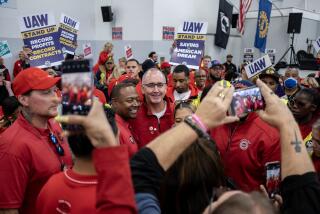COLUMN ONE : Southeast Shows How to Nail Jobs : The region puts out the welcome mat for foreign firms. Emphasis on high-tech investments, training skilled labor pays off as these states emerge from the recession first.
LAURINBURG, N.C. â You can see a new day dawning here in rural North Carolina where Jeff Oxendine likes his work at the truck transmission plant better than his old job at the textile plant. He can move around from task to task here, and increase his pay if he learns new skills.
Across the state line in South Carolina, where names like Siemens, Rucker, Hoechst and Bayer dot Interstate 85, you can see foreign investment at work. Non-U.S. companies employ 6% of the work force and they are soon to be joined by BMW, the Munich-based luxury car maker that is building a production plant near Greenville.
And you can see the effect of buzzwords like technology and infrastructure in Gray and Boones Creek, Tenn., small towns in the Great Smoky Mountains, where computer record-keeping for Sears Roebuckâs credit operations provides new jobs thanks to the spread of advanced telecommunications lines and equipment.
What the above examples say is that the Clinton Administration is in for a surprise. Some of its most ambitious ideas for helping U.S. industry are already working in many parts of the country, particularly the Southeast.
The Carolinas, Tennessee and Kentucky could teach the rest of the nation lessons in adapting to the global economy. In collaborations of state governments and industry, they have welcomed advanced technology, devised new ways to train their work forces and put out a welcome mat for foreign investment--especially in technically demanding industries.
They represent a new pattern--smaller, poorer states showing the way in innovation and economic recovery to large industrial states such as California, Illinois and New York. If most of the nation is now clearly coming out of recession, the Southeastern states emerged first and suffered less during this recent downturn--unemployment levels have been consistently below national averages in recent years.
In a sense, the Southeast is like a hungry ballplayer, eager to make the big leagues. Per capita incomes in the Carolinas and Tennessee are only three quarters as high as incomes in the bigger states--but a whole lot more than incomes used to be 30 years ago, when the region knew mostly scrub farming and minimum wages.
The regionâs people are eager to work because they see a chance to buy good homes, which can be had for under $100,000--far less than the price of houses in Northern industrial areas and most sections of California.
So when the regionâs politicians and state officials offer incentives to attract new industry, they do so with a lot of backing from the voters. The response a top executive of a major company got from a California state official--âI donât care where you locate your next plantâ--would be unthinkable in the Carolinas and Tennessee.
While big industrial states struggle with tax burdens and a swollen cost structure due to high wages and premiums on health insurance and workersâ compensation, the Southeastern states see competitive advantage.
âThis area will continue to attract industry because Northern states like to tax and regulate and drive business away,â says Wayne Sterling, director of the South Carolina Development Board, which is charged with recruiting companies to invest in the state.
The rich states are no longer sleeping. Gov. Pete Wilson and Assembly Speaker Willie Brown will hold a two-day economic summit starting Tuesday in Los Angeles to discuss ways in which California can improve its economy.
To be sure, there are aspects to being a hungry, insurgent region that richer, more developed states would find unattractive. South Carolina, for instance, is devoutly non-union. The state passed up a chance to bid for General Motorsâ Saturn plant--a $3-billion investment, that went to Tennessee--because it would mean taking in the United Auto Workers.
Wages in the Carolinas and Tennessee are 13% to 23% lower than those in California or New Jersey. And lower wages reflect lower productivity, says the manager of a newly opened factory, who finds that the areaâs work force is inexperienced and in need of training.
But both North and South Carolina recognized that failing long ago and did something about it. Now, once a company decides to set up an operation in either state, employees are trained at public expense to the specific needs of the companyâs business. Then the states follow up, tailoring the curricula of their community colleges to industryâs changing requirements.
The region is trying to sell upgraded, skilled labor because âcheapâ labor doesnât make sense in a time when enormous investments in technology stand behind all manufacturing jobs.
âIt used to be $125,000 of investment for each job,â says South Carolinaâs Sterling, ânow itâs $219,000.â
So the state governments emphasize worker training--which goes beyond simple literacy to the logic necessary for operating computerized machines. And they foster something more, new attitudes and methods in industrial relations.
Call it worker empowerment or worker democracy, the new methods being employed in factories here will make American industrial relations the hallmark of the â90s as German worker-directors and Japanese quality circles were the big news of previous decades.
The best known example is the Saturn car plant at Spring Hill, Tenn., where General Motors managers and United Auto Workers employees share decision making on all matters affecting the plant, including investment and future planning.
âThis is decision making by the rank and file,â says Mike Bennett, head of the UAW local at Saturn. So far the Saturn car is a great hit with customers; production will be expanded this year to include a Saturn station wagon. And the union voted to renew the unique Saturn labor agreement, which guarantees employees only 80% of the industry average wage but allows them to earn the remaining 20% and more through performance incentives.
Less well known but equally representative of the new thinking is Rockwell Internationalâs truck transmission plant here in Laurinburg, 100 miles east of Charlotte. The companyâs automotive division has invested $70 million to initiate a new product line in a plant using a previously untrained work force.
And it has been successful, entering competition in truck transmissions against Eaton Corp. and Dana Corp., leaders in that field, and gaining a 13% share of market in a few short years.
Key to the Laurinburg plantâs success is that Rockwell employs a team approach, which gives factory employees a lot of responsibility and encourages them to learn new skills to earn more pay.
âThere was dissatisfaction with old ways of running factories,â says Richard DeRose, human resources manager at Laurinburg, recalling his previous job at a Rockwell drive shaft plant in Michigan. âManagers were there to be problem solvers, everybody else was there to work.
âThat didnât give the average employee much responsibility for results,â says DeRose. Instead it encouraged an attitude of âI just work here . . . they donât pay me to think.â
Thatâs just the wrong attitude for todayâs fast-changing global environment. âWho loses their job when the product becomes obsolete, when the company becomes uncompetitive?â asks DeRose. âThe job losses are on the line before theyâre in the front office.â
So at Laurinburg, employees move around from task to task and up through pay levels starting at about $350 a week and earning $21 a week more for each new skill they acquire.
Jeff Oxendine, running a tool setter at Laurinburg, is taking courses at Richmond Technical College in nearby Rockingham so that he can improve his pay. âItâs a lot better than the textile plant where you just did one job,â he says.
And Craig Pryor, manager at Laurinburg, likes the system. âOur real strength may lie in empowerment,â Pryor says, and that has surprised him. A skilled plant manager at Ford Motor Co. before coming to Rockwell 20 years ago, Pryor saw immediately that workers in the Laurinburg area had no experience and needed a lot of training. Yet today, having worked with this system, he says: âIf we took all the managers out of the plant, it could run just as well.â
What made the difference? North Carolinaâs community colleges, such as the facility at Rockingham, helped by providing training at state expense. Before Rockwell started production, the college purchased truck transmissions and trained the companyâs workers.
A training college system working directly for industry is an innovation the Carolinas pioneered. South Carolina, the home state of new Education Secretary Richard W. Riley--who was South Carolinaâs governor from 1978 to 1986--has 16 two-year technical community colleges with 56,000 students and an annual budget of $130 million.
Under Riley, South Carolina embarked on a $1.5-billion Education Improvement program that has improved its elementary and high school test scores. And it expanded the community colleges, which offer an education focused on industry.
âUnlike most community colleges, our special schools are not based on a baccalaureate academic model,â says James Morris, head of South Carolinaâs system. âWe have a dynamic curriculum that we evaluate annually to keep up with technology and what employers want.â
Its education system has helped attract major investments in South Carolina from Michelin, the French tire maker; Siemens, the German electrical giant; along with Hoechst, Bayer and BASF, the big three German chemical companies.
In fact, state and region offer a full-sized demonstration of the thinking of Robert B. Reich, the new labor secretary. In his book âThe Work of Nations,â Reich argues that U.S. success in the global economy will come not from protectionism but from education and improvement of the American work force, so that international corporations will want to bring their jobs here.
The Southeast has become a magnet for the world automotive industry. Nissan and Toyota have their U.S. production plants in Tennessee and Kentucky; Bridgestone Tire now makes its U.S. headquarters in Nashville. And BMW is investing $400 million to build a production plant in South Carolina.
BMW vice president Karl Flescher says the German auto maker will develop a new model in the South Carolina plant, produce 60,000 cars a year and export up to half of them back to Europe. The German auto maker chose South Carolina, Flescher explains, because the state offered âtraining for our workers and a good infrastructure--a nearby airport and three and a half hours by highway to the port of Charleston.â The BMW plantâs volume of shipping promises to revitalize the great 19th-Century port of Charleston.
While the plant is being built, Flescher has set up an office in Spartanburg, S.C., along Interstate 85, where more than 40% of the businesses are foreign-owned. South Carolina, a green and mostly rural state of only 3.5 million people, has attracted $5 billion in foreign investment since 1985--almost $1.5 billion of it in 1992 alone.
The stateâs attraction for foreign companies dates to the 1960s when South Carolina needed to find new job-creating industry to replace its traditional textile mills, which were automating. Then-governor, now U.S. Sen. Ernest F. Hollings sent a delegation to Germany to recruit Robert Bosch, a sophisticated maker of automobile parts.
The choice of industry marked a big change in the old Confederacy: South Carolina didnât go into the world saying its then-poorly educated work force--which is 30% black--could weave a cotton garment as cheaply as Hong Kong. Rather, it said its work force would begin receiving a better education and would produce precision auto parts as skillfully as Stuttgart. The strategy paid off; today unemployment is low, pay and living standards are rising in South Carolina.
The region is technologically ahead of most parts of the nation. Tennessee in particular is on the cutting edge of telecommunications--and a possible inspiration for the thinking of Vice President Al Gore, a Tennessean, who advocates building a nationwide computerized information highway.
The Tennessee Public Service Commission has been pushing telephone companies in the state--South Central Bell and 26 others--to install the most advanced telecommunications networks under a 10-year, $400-million program that began in 1990.
The intent was to provide a modern infrastructure to bring jobs not only to Tennesseeâs big cities--Memphis, Nashville, Knoxville and Chattanooga--but to its ample rural areas. High capacity telephone lines have been extended into remote areas.
One result is that Sears Roebuck has its credit accounts tallied on computers in small, rural Gray and Boones Creek. Also, digital switching equipment has allowed the tiny Telecos cooperative phone company in central Tennessee near Knoxville to provide rapid fax and computer links between the United States and Japan for Matsushita, which has brought 400 jobs to the area.
âTennesseeâs commitment to a high-tech telecommunications infrastructure has been a major factor in bringing new industry,â says Public Service Commissioner Steve Hewlett. Heâs referring specifically to the expansion of the 10-year-old Nissan auto plant and the building of Saturnâs $3-billion complex south of Nashville--with their heavy demands for highway and telecommunications links to facilitate just-in-time delivery of supplies.
The significance of the Tennessee telecommunications plan is that it is accelerating the pace of change by encouraging the earlier deployment of advanced technology.
That costs money. To finance the $400-million program, Hewlettâs commission allowed South Central Bell and other phone companies to reinvest some of their profits rather than return them to customers in the form of lower rates. The thinking was that the stateâs consumers would benefit more from an increase in jobs and general economic activity than from slightly lower monthly phone bills.
The program has given Tennessee one of the most advanced phone systems in the country. Last month, residential and business customers began an experiment with digital phone service that can receive voice, computer data and fax transmissions simultaneously. What business applications will result from such innovation, no one can predict precisely. But Tennessee business leaders and state officials are confident there will be benefits.
The Southeast is a region steeped in history--Civil War, devastation, reconstruction, discrimination, civil rights and development. But it is no longer trapped in history. Despite the Confederate stars and bars still flying over South Carolinaâs Capitol at Columbia, the region is eager to meet the demands of a new industrial age for educated people, modern technology and a cooperative relationship between government and business.
Other regions can learn something from the Southeast, and perhaps so can a new Administration in Washington that comes to office pledged to bring industrial renewal to all of the United States.
More to Read
Inside the business of entertainment
The Wide Shot brings you news, analysis and insights on everything from streaming wars to production â and what it all means for the future.
You may occasionally receive promotional content from the Los Angeles Times.









